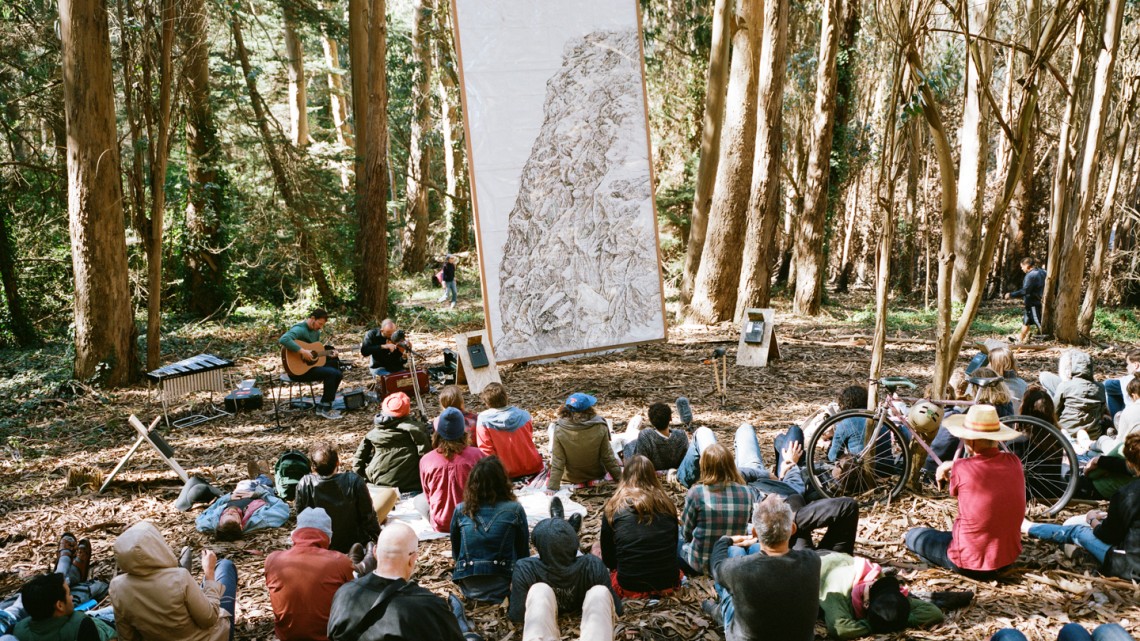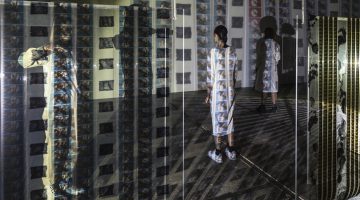The winners of this year’s SFMOMA SECA (Society for the Encouragement of Contemporary Art) Award are Josh Faught, Jonn Herschend, Zarouhie Abdalian and David Wilson. The off-site SFMOMA SECA Award exhibitions began September 14th and will conclude this weekend on November 17th. SECA Award Part 2 includes David Wilson and Jonn Herschend.
Broadly speaking, both David Wilson and Jonn Herschend are working with concepts of relocation and mapping in their work. While Wilson works with mapping in a literal sense, such as street maps, Herschend maps time through his film work. Each of them remarks on the human conditions that arise when people are subject to changes of their surroundings. Those surroundings depart from the singular nexus of SFMOMA itself, and extend into two realms that relocate viewers: reality and fiction. But reality and fiction bleed into one other in each artist’s work creating dynamic modes of engagement for viewers.
David Wilson’s SECA Award contribution, “Arrivals” has been in a constant state of flux, as new pieces and contributions get added to the installation and online documentation over the last two months. Wilson has been offering up prints of hand-drawn maps since the opening of the SECA Award exhibition in early September. Housed in a kiosk in front of the museum, the maps could be picked up by passer-by. Each map included a walking tour to various locations, each of which also featured an accompanying sound work, or “soundtrack” for the location. At the time this article is written there are 4 soundtracks available on the SFMOMA website: Two for the beginning location at the Presidio, one for Chinatown and one for Bernal.
The first location in “Arrivals” is at the Presidio. For the opening, a group of us visited the location at the National Cemetery Overlook on the Cemetery Connector Trail. A huge 16 foot tall drawing is strapped to a redwood tree. The piece titled “Frog Woman Rock” is comprised of 3 sectional drawings attached together to create one large portrait of a mountainous cliff. The cliff is located at the Russian River, a place that Wilson frequents. For him it is a portal to the Bay, and a place of potential. Wilson visited the site for up to 10 hours a day for 9 days to work on the drawing. The disparate location of the Russian River is symbolic of relocation, and passageways that people take to arrive at what will later become a final destination. This is a poignant phenomenon to consider when taking the cemetery location into account. Although framed behind Plexiglass and secured to the tree to the best of human capability, the drawing is still completely exposed to the elements and people passing by. The drawing becomes symbolic of life itself as a fragile thing that is left outside to brave the elements and decay over time. In compliment to the drawing, the sound work created at the space reiterates the ephemeral nature of time, weather, decay of the drawing and the original purpose of the location as a resting place for the dead and a gathering place for the living. Wilson embraces the gathering of people whole-heartedly through extensive collaborations in his work. For the Presidio performance, a small group of people came together to listen and to perform next to the big drawing amongst the trees. The soundtrack is split into Side A and Side B, like a 45 rpm record would be.
Side A is an original composition created by Danny Paul Grody, Tony Cross and Andy Cabic. Gentle bell-tones emerge from the rustling hum of over-arching white noise. Waves of water hush behind ambient electronics and occasional plucks and breaths of a harmonium. Long, drawn out sharp chords of someone rubbing wine glasses is softened by guitar. The piece is very minimal, and certainly comparable to John Cage’s early “Imaginary Landscape” works, but less theatrical. Rather, Wilson’s collaboration is more contemplative and still. Part B of the Presidio soundtrack includes a round of songs including one by the composer Moondog, which Wilson confesses was on his mind while he was making the drawing. Moondog was a blind composer, but his works had been transferred from Braille to sheet music in the 1980s, while in Germany. Moondog’s inspiration was drawn from urban sounds, particularly the fog-horn, which is an appropriate default inspiration for San Francisco, even though Moondog did most of his early work in New York. To continue, Part B is an impromptu selection of songs, segmented by pauses and rustling noises as the troupe situates themselves, adjusting the microphone. The whole track is light-hearted, including “Blue Moon”, “Moon River” and a song by Ben Belknap and Sarah Simon called “Keeper of the Mountain”. Other performers were Wilson, Meara O’Reilly, Jeremy Harris, Colter Jacobsen and Sara Gambin. The songs become a group sing-along, the listeners joining in and fading out when they can’t remember the words – making the listener aware of the multiple voices gathered there, which become further reminders of comings and goings, of places of stasis that are in constant transition.
Jonn Herschend’s film “Stories from the Evacuation” takes place in SFMOMA during the early stages of the renovation prior to construction. Acting as a documentary, the film captures candid responses from museum staff as they prepare the museum’s collection and offices for the transition out of the space and into a state of flux. The film begins with the senior museum preparator recalling a dream he had that ends in a museum “no-man’s land” at the top of the seventh floor where the elevator doors open up to nowhere: “That’s it,” he quips. Serene and tinkling music softly spills over a series of still shots that feature major artworks wrapped in plastic sheeting, lined in racks, arrows pointing upward. The camera follows a man through a cream, beige and grey office – partially deflated Mylar balloons linger near an abandoned filing cabinet. Soon the viewer is introduced to Kelly, a relocation specialist.
Believable, her professional demeanor assures those concerned for the well-being of the museum staff that they are all being taken care of during this difficult time. Character Jared Patrick (Public Relations Coordinator) appears to confess his feelings of adaptation for the move, but confusion is setting in for some local viewers because they recognize that Jared is played by local Bay Area artist Packard Jennings. At first it seems unclear why a recognized artist would appear in this context and questions come to mind: perhaps Jennings moonlights at the museum and does not want his real name revealed or maybe the real Jared is camera shy and does not want his face shown? Cut to more footage of museum staff describing their take on the move, the same music still carrying the bittersweet tone. Eventually it becomes clear that the film is a hybrid of reality and fiction, as the two characters Jared and Kelly behave more bizarre and the narrative takes a detour away from the museum.
Herschend’s film began as a documentary, but through his process of filming an alternate story emerged. The cinematography and editing is similar to a parody sit-com. The kind of sitcoms that are strangely realistic, featuring characters that are an exaggeration of people that can be found any day of the week at the coffee shop, in relationships, and yes perhaps even people working in museums. The difference is that in “Stories of the Evacuation”, some of the characters are actual museum staff, not parodies of themselves, but rather they are who they are. The people of the documentary and the characters of the parody intertwine, creating a disruption of reality. However, reality is just that: the museum is closed until 2015. The film’s running time is the same as a television show but without the commercials (22:23 minutes). It ends on an abrupt note leaving the viewer wanting more, just like making the anticipation for the following week’s episode something to look forward to. Perhaps another “episode” of “Stories of the Evacuation” would be apropos in the near future so that waiting for the sequel of SFMOMA will go by a little faster.
SFAQ Review: SECA Award Part 1 can be read here.
Jonn Herschend’s film, Stories from the Evacuation can be viewed here.
For more information on David Wilson’s “Arrivals” visit here.
-Contributed by Leora Lutz.







